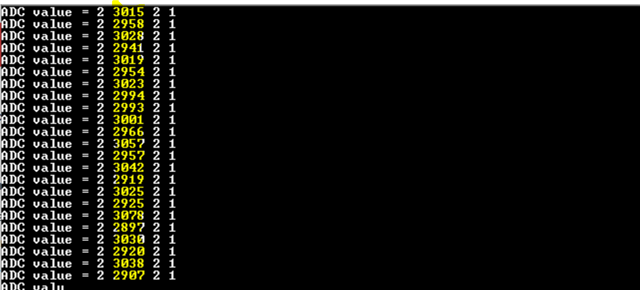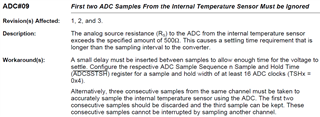Other Parts Discussed in Thread: TM4C123GH6PM
Hi Team
I am trying to read iternal ADC in tm4c1294x EVK channel by giving 3.3 internal voltage
this is my code to read PE2 GPIO channel1
I could read only 2900-3000 as raw value could not get exactly 3300
PFA of the source code can you please review it and can tell any changes to be mad
/*
* Adc.c
*
* Created on: Aug 30, 2023
* Author: balasubramanian_sund
*/
//*****************************************************************************
//
// temperature_sensor.c - Example demonstrating the internal ADC temperature
// sensor.
//
// Copyright (c) 2010-2014 Texas Instruments Incorporated. All rights reserved.
// Software License Agreement
//
// Redistribution and use in source and binary forms, with or without
// modification, are permitted provided that the following conditions
// are met:
//
// Redistributions of source code must retain the above copyright
// notice, this list of conditions and the following disclaimer.
//
// Redistributions in binary form must reproduce the above copyright
// notice, this list of conditions and the following disclaimer in the
// documentation and/or other materials provided with the
// distribution.
//
// Neither the name of Texas Instruments Incorporated nor the names of
// its contributors may be used to endorse or promote products derived
// from this software without specific prior written permission.
//
// THIS SOFTWARE IS PROVIDED BY THE COPYRIGHT HOLDERS AND CONTRIBUTORS
// "AS IS" AND ANY EXPRESS OR IMPLIED WARRANTIES, INCLUDING, BUT NOT
// LIMITED TO, THE IMPLIED WARRANTIES OF MERCHANTABILITY AND FITNESS FOR
// A PARTICULAR PURPOSE ARE DISCLAIMED. IN NO EVENT SHALL THE COPYRIGHT
// OWNER OR CONTRIBUTORS BE LIABLE FOR ANY DIRECT, INDIRECT, INCIDENTAL,
// SPECIAL, EXEMPLARY, OR CONSEQUENTIAL DAMAGES (INCLUDING, BUT NOT
// LIMITED TO, PROCUREMENT OF SUBSTITUTE GOODS OR SERVICES; LOSS OF USE,
// DATA, OR PROFITS; OR BUSINESS INTERRUPTION) HOWEVER CAUSED AND ON ANY
// THEORY OF LIABILITY, WHETHER IN CONTRACT, STRICT LIABILITY, OR TORT
// (INCLUDING NEGLIGENCE OR OTHERWISE) ARISING IN ANY WAY OUT OF THE USE
// OF THIS SOFTWARE, EVEN IF ADVISED OF THE POSSIBILITY OF SUCH DAMAGE.
//
// This is part of revision 2.1.0.12573 of the Tiva Firmware Development Package.
//
//*****************************************************************************
/*
* This code was made to show a simple ADC read.
*
* It was made from the example provided by TivaWare but it was a some modifications
* like the math
*
*
* Luís Afonso
*
*
*/
//#define PART_TM4C123GH6PM
#include <stdint.h>
#include <stdbool.h>
#include "stdlib.h"
#include "inc/hw_ints.h"
#include "inc/hw_memmap.h"
#include "inc/hw_uart.h"
#include "inc/hw_gpio.h"
#include "inc/hw_pwm.h"
#include "inc/hw_types.h"
#include "driverlib/adc.h"
#include "driverlib/timer.h"
#include "driverlib/gpio.h"
#include "driverlib/interrupt.h"
#include "driverlib/pin_map.h"
#include "driverlib/rom.h"
#include "driverlib/rom_map.h"
#include "driverlib/sysctl.h"
#include "driverlib/uart.h"
#include "driverlib/udma.h"
#include "driverlib/pwm.h"
#include "driverlib/ssi.h"
#include "driverlib/systick.h"
#include "driverlib/adc.h"
#include "utils/uartstdio.h"
#include <string.h>
#include "Adc.h"
volatile uint32_t millis=0;
void SycTickInt(){
millis++;
}
void SysTickbegin(){
SysTickPeriodSet(80000);
SysTickIntRegister(SycTickInt);
SysTickIntEnable();
SysTickEnable();
}
void Wait(uint32_t time){
uint32_t temp = millis;
while( (millis-temp) < time){
}
}
//*****************************************************************************
//
// This function sets up UART0 to be used for a console to display information
// as the example is running.
//
//*****************************************************************************
void
InitConso(void)
{
//
// Enable GPIO port A which is used for UART0 pins.
// TODO: change this to whichever GPIO port you are using.
//
SysCtlPeripheralEnable(SYSCTL_PERIPH_GPIOA);
//
// Configure the pin muxing for UART0 functions on port A0 and A1.
// This step is not necessary if your part does not support pin muxing.
// TODO: change this to select the port/pin you are using.
//
GPIOPinConfigure(GPIO_PA0_U0RX);
GPIOPinConfigure(GPIO_PA1_U0TX);
//
// Enable UART0 so that we can configure the clock.
//
SysCtlPeripheralEnable(SYSCTL_PERIPH_UART0);
//
// Use the internal 16MHz oscillator as the UART clock source.
//
UARTClockSourceSet(UART0_BASE, UART_CLOCK_PIOSC);
//
// Select the alternate (UART) function for these pins.
// TODO: change this to select the port/pin you are using.
//
GPIOPinTypeUART(GPIO_PORTA_BASE, GPIO_PIN_0 | GPIO_PIN_1);
//
// Initialize the UART for console I/O.
//
UARTStdioConfig(0, 115200, 16000000);
}
int Adc(){
SysCtlClockSet(SYSCTL_SYSDIV_2_5|SYSCTL_USE_PLL|SYSCTL_OSC_MAIN|SYSCTL_XTAL_16MHZ);
/* uint32_t g_ui32SysClock =0;
g_ui32SysClock = MAP_SysCtlClockFreqSet((SYSCTL_XTAL_25MHZ |
SYSCTL_OSC_MAIN |
SYSCTL_USE_PLL |
SYSCTL_CFG_VCO_240), 120000000);*/
SysTickbegin();
InitConso();
//
// This array is used for storing the data read from the ADC FIFO. It
// must be as large as the FIFO for the sequencer in use. This example
// uses sequence 3 which has a FIFO depth of 1. If another sequence
// was used with a deeper FIFO, then the array size must be changed.
//
uint32_t ADCValues[1]={0};
// uint32_t ADCValues[0]={0};
//
// These variables are used to store the temperature conversions for
// Celsius and Fahrenheit.
//
uint32_t TempValueC = 0;
// uint32_t TempValueF;
uint32_t ui32Count =0;
//
// Display the setup on the console.
//
UARTprintf("ADC ->\n");
UARTprintf(" Type: Internal Temperature Sensor\n");
UARTprintf(" Samples: One\n");
UARTprintf(" Update Rate: 250ms\n");
UARTprintf(" Input Pin: Internal temperature sensor\n\n");
//
// The ADC0 peripheral must be enabled for use.
//
SysCtlPeripheralEnable(SYSCTL_PERIPH_ADC0);
//ADCClockConfigSet(ADC0_BASE, ADC_CLOCK_SRC_PIOSC | ADC_CLOCK_RATE_HALF, 1);
SysCtlDelay(3);
SysCtlPeripheralEnable(SYSCTL_PERIPH_GPIOE);
GPIOPinTypeADC(GPIO_PORTE_BASE,GPIO_PIN_2);
//
// Enable sample sequence 3 with a processor signal trigger. Sequence 3
// will do a single sample when the processor sends a singal to start the
// conversion. Each ADC module has 4 programmable sequences, sequence 0
// to sequence 3. This example is arbitrarily using sequence 3.
//
ADCSequenceDisable(ADC0_BASE, 3);
ADCSequenceConfigure(ADC0_BASE, 3, ADC_TRIGGER_PROCESSOR, 0);
ADCReferenceSet(ADC0_BASE, ADC_REF_INT);
//
// Configure step 0 on sequence 3. Sample the temperature sensor
// (ADC_CTL_TS) and configure the interrupt flag (ADC_CTL_IE) to be set
// when the sample is done. Tell the ADC logic that this is the last
// conversion on sequence 3 (ADC_CTL_END). Sequence 3 has only one
// programmable step. Sequence 1 and 2 have 4 steps, and sequence 0 has
// 8 programmable steps. Since we are only doing a single conversion using
// sequence 3 we will only configure step 0. For more information on the
// ADC sequences and steps, reference the datasheet.
//
ADCSequenceStepConfigure(ADC0_BASE, 3, 0, ADC_CTL_CH1 | ADC_CTL_IE |
ADC_CTL_END);
//ADCHardwareOversampleConfigure(ADC0_BASE,64);
//
// Since sample sequence 3 is now configured, it must be enabled.
//
ADCSequenceEnable(ADC0_BASE, 3);
//
// Clear the interrupt status flag. This is done to make sure the
// interrupt flag is cleared before we sample.
//
ADCIntClear(ADC0_BASE, 3);
//
// Sample the temperature sensor forever. Display the value on the
// console.
//
while(1)
{
//
// Trigger the ADC conversion.
//
ADCProcessorTrigger(ADC0_BASE, 3);
//
// Wait for conversion to be completed.
//
while(!ADCIntStatus(ADC0_BASE, 3, false))
{
}
SysCtlDelay(3);
//
// Clear the ADC interrupt flag.
//
ADCIntClear(ADC0_BASE, 3);
//
// Read ADC Value.
//
ui32Count = ADCSequenceDataGet(ADC0_BASE, 3, ADCValues);
//
// Use non-calibrated conversion provided in the data sheet. I use floats in intermediate
// math but you could use intergers with multiplied by powers of 10 and divide on the end
// Make sure you divide last to avoid dropout.
//
// TempValueC = (uint32_t)(147.5 - ((75.0*3.3 *(float)ADCValues[0])) / 4096.0);
TempValueC = ((ADCValues[0] * 3.3) / 4095 );
//
// Get Fahrenheit value. Make sure you divide last to avoid dropout.
//
// TempValueF = ((TempValueC * 9) + 160) / 5;
//
// Display the temperature value on the console.
//
UARTprintf("ADC value = %d %4d %d %d\r\n", TempValueC, ADCValues[0] ,ADCValues[1], ui32Count);
//
// This function provides a means of generating a constant length
// delay. The function delay (in cycles) = 3 * parameter. Delay
// 250ms arbitrarily.
//
SysCtlDelay(16000000 / 12);
ADCValues[0]=0;
ADCValues[1] =0;
TempValueC = 0;
}
}
My output values is like this for 3.3 v input which I marked in yellow shades

please try to solve the issue





